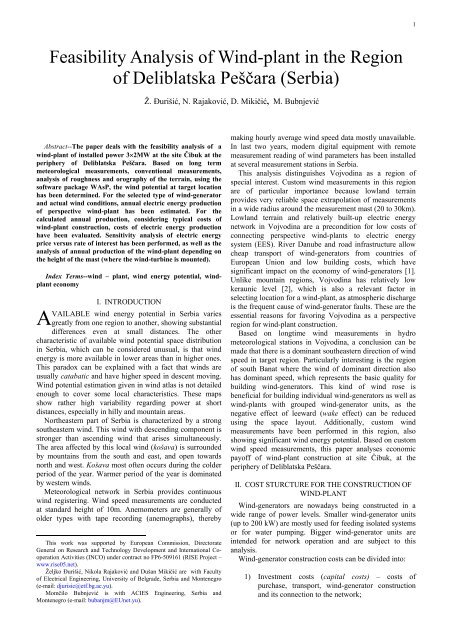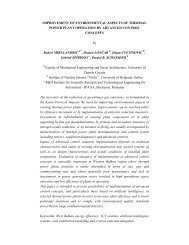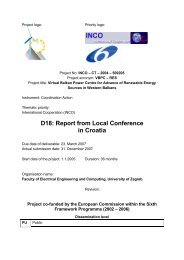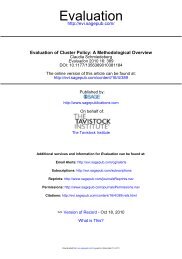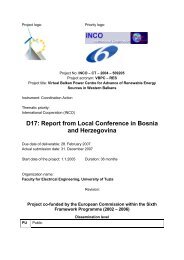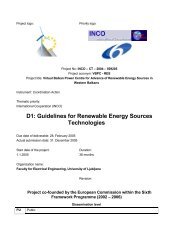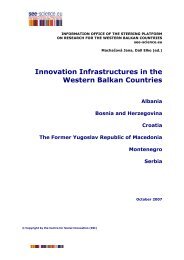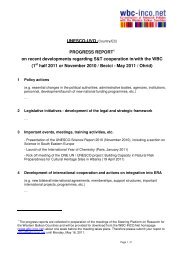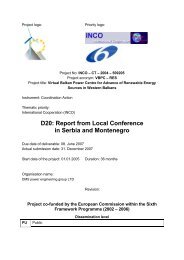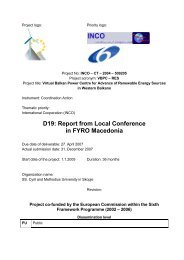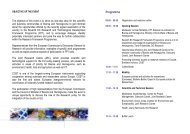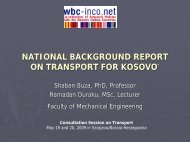Prva stran - WBC-INCO Net
Prva stran - WBC-INCO Net
Prva stran - WBC-INCO Net
Create successful ePaper yourself
Turn your PDF publications into a flip-book with our unique Google optimized e-Paper software.
Feasibility Analysis of Wind-plant in the Region<br />
of Deliblatska Peščara (Serbia)<br />
Abstract--The paper deals with the feasibility analysis of a<br />
wind-plant of installed power 3×2MW at the site Čibuk at the<br />
periphery of Deliblatska Peščara. Based on long term<br />
meteorological measurements, conventional measurements,<br />
analysis of roughness and orography of the terrain, using the<br />
software package WAsP, the wind potential at target location<br />
has been determined. For the selected type of wind-generator<br />
and actual wind conditions, annual electric energy production<br />
of perspective wind-plant has been estimated. For the<br />
calculated annual production, considering typical costs of<br />
wind-plant construction, costs of electric energy production<br />
have been evaluated. Sensitivity analysis of electric energy<br />
price versus rate of interest has been performed, as well as the<br />
analysis of annual production of the wind-plant depending on<br />
the height of the mast (where the wind-turbine is mounted).<br />
Index Terms--wind – plant, wind energy potential, windplant<br />
economy<br />
I. INTRODUCTION<br />
VAILABLE wind energy potential in Serbia varies<br />
A<br />
greatly from one region to another, showing substantial<br />
differences even at small distances. The other<br />
characteristic of available wind potential space distribution<br />
in Serbia, which can be considered unusual, is that wind<br />
energy is more available in lower areas than in higher ones.<br />
This paradox can be explained with a fact that winds are<br />
usually catabatic and have higher speed in descent moving.<br />
Wind potential estimation given in wind atlas is not detailed<br />
enough to cover some local characteristics. These maps<br />
show rather high variability regarding power at short<br />
distances, especially in hilly and mountain areas.<br />
Northeastern part of Serbia is characterized by a strong<br />
southeastern wind. This wind with descending component is<br />
stronger than ascending wind that arises simultaneously.<br />
The area affected by this local wind (košava) is surrounded<br />
by mountains from the south and east, and open towards<br />
north and west. Košava most often occurs during the colder<br />
period of the year. Warmer period of the year is dominated<br />
by western winds.<br />
Meteorological network in Serbia provides continuous<br />
wind registering. Wind speed measurements are conducted<br />
at standard height of 10m. Anemometers are generally of<br />
older types with tape recording (anemographs), thereby<br />
This work was supported by European Commission, Directorate<br />
General on Research and Technology Development and International Cooperation<br />
Activities (<strong>INCO</strong>) under contract no FP6-509161 (RISE Project –<br />
www.rise05.net).<br />
Željko Đurišić, Nikola Rajaković and Dušan Mikičić are with Faculty<br />
of Electrical Engineering, University of Belgrade, Serbia and Montenegro<br />
(e-mail: djurisic@etf.bg.ac.yu).<br />
Momčilo Bubnjević is with ACIES Engineering, Serbia and<br />
Montenegro (e-mail: bubanjm@EUnet.yu).<br />
Ž. Đurišić, N. Rajaković, D. Mikičić, M. Bubnjević<br />
making hourly average wind speed data mostly unavailable.<br />
In last two years, modern digital equipment with remote<br />
measurement reading of wind parameters has been installed<br />
at several measurement stations in Serbia.<br />
This analysis distinguishes Vojvodina as a region of<br />
special interest. Custom wind measurements in this region<br />
are of particular importance because lowland terrain<br />
provides very reliable space extrapolation of measurements<br />
in a wide radius around the measurement mast (20 to 30km).<br />
Lowland terrain and relatively built-up electric energy<br />
network in Vojvodina are a precondition for low costs of<br />
connecting perspective wind-plants to electric energy<br />
system (EES). River Danube and road infrastructure allow<br />
cheap transport of wind-generators from countries of<br />
European Union and low building costs, which have<br />
significant impact on the economy of wind-generators [1].<br />
Unlike mountain regions, Vojvodina has relatively low<br />
keraunic level [2], which is also a relevant factor in<br />
selecting location for a wind-plant, as atmospheric discharge<br />
is the frequent cause of wind-generator faults. These are the<br />
essential reasons for favoring Vojvodina as a perspective<br />
region for wind-plant construction.<br />
Based on longtime wind measurements in hydro<br />
meteorological stations in Vojvodina, a conclusion can be<br />
made that there is a dominant southeastern direction of wind<br />
speed in target region. Particularly interesting is the region<br />
of south Banat where the wind of dominant direction also<br />
has dominant speed, which represents the basic quality for<br />
building wind-generators. This kind of wind rose is<br />
beneficial for building individual wind-generators as well as<br />
wind-plants with grouped wind-generator units, as the<br />
negative effect of leeward (wake effect) can be reduced<br />
using the space layout. Additionally, custom wind<br />
measurements have been performed in this region, also<br />
showing significant wind energy potential. Based on custom<br />
wind speed measurements, this paper analyses economic<br />
payoff of wind-plant construction at site Čibuk, at the<br />
periphery of Deliblatska Peščara.<br />
II. COST STURCTURE FOR THE CONSTRUCTION OF<br />
WIND-PLANT<br />
Wind-generators are nowadays being constructed in a<br />
wide range of power levels. Smaller wind-generator units<br />
(up to 200 kW) are mostly used for feeding isolated systems<br />
or for water pumping. Bigger wind-generator units are<br />
intended for network operation and are subject to this<br />
analysis.<br />
Wind-generator construction costs can be divided into:<br />
1) Investment costs (capital costs) – costs of<br />
purchase, transport, wind-generator construction<br />
and its connection to the network;<br />
1


